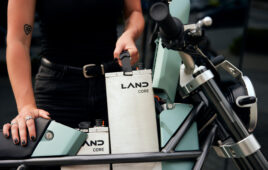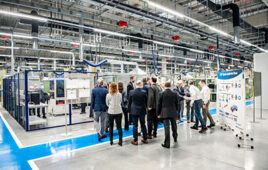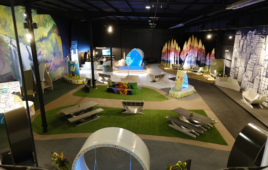The wind energy industry spends a great deal of energy to spin faster, longer, and generate more energy. An often-overlooked and under-appreciated part of the wind-turbine system is the brakes. They perform important jobs in wind turbines, but most importantly, they keep the turbine system operating in control and as efficiently as possible. For example, brakes hold blade pitch steady and keep the nacelle pointed in the right direction. Brakes also steady the turbine in a violent storm mitigating the risk of damage while protecting the operator’s investment. However, as wind-turbine OEMs build larger units (over 1.5 MW), brake engineers will have to find new ways to generate more braking power within a confined and shrinking space. Several trends in the industry are showing how brake manufacturers are meeting these needs, including:
• Developing more reliable systems
• Designing service access into the braking systems
• System bundling
• Noise reduction
• And cost improvements
Reliable systems
Due to the location and design of wind turbines, reliability is a key factor in minimizing maintenance and service. Industrial brakes have adapted to meet this need in many other industries, but are now focused on wind-power generation. For electric pitch drives, brakes have trended toward high-torque, electrically released, spring engaged, static holding brakes that can withstand the severe conditions in pitch drives on large turbines. “One pitch brake is rated for 15,000 to 30,000 dynamic stops, depending on coil and voltage required, far exceeding the typical design life criteria of 500 to 1,000 stops,” says Warner Electric’s Engineer Rich Silvestrini.
Ease of service
Brake manufacturers are also beginning to understand the importance of service. O&M crews may not be the group making the initial purchase decision, but it is important that their needs are included in decisions. When maintenance issues arise, crews want to know they can get in quick, fix the problem, and return the turbine to service. “We’ve noticed more turbine customers expressing the need for ease-of-service and maintenance,” says Joshua Gildea of Carlisle Brake & Friction. “In terms of service, caliper brakes with retractable thrust plates make linings easy to replace and minimize downtime.”
Noise reduction
As wind farms are built closer to population centers, their impact on their surroundings also becomes more important. At times, brakes can lead to problems when the turbine tower acts as a “trumpet” and magnifies the screeching and rubbing noises created by brakes. Several brake manufacturers have invested research into new linings that significantly minimize noise in a turbine. Gildea says caliper brakes are working in the wind market–along with mining, construction, military, and agriculture–so it’s important to understand the “physics” behind effective braking systems–most importantly the friction. To that end, his company has partnered with and acquired other companies with extensive R&D facilities that focus on friction and noise reduction.
System bundling and integration
Another trend in brakes is one-stop shopping. While each wind turbine combines technology from a variety of vendors for the best possible performance, operators want to know that won’t have to talk to a dozen different manufacturers to solve service problems. Carlisle’s Gildea, for example, says his company now supplies hydraulic power units, hoses, and replacement lines along with the brakes it designs so companies need not patch together brake systems from parts purchased from several companies.
Braking manufacturers are also working closely with wind-turbine manufacturers to create a brake design for each specific turbine model. For example, one current problem is where to locate the rotor brake. Rotor brakes control over-speed, and provide parking and emergency braking. These brakes can be mounted either on the rotor (low-speed shaft) or on the generator (high-speed shaft), and in some cases, both.
Such requirements are more difficult to meet on the high-speed shaft because speed and space are limiting factors with regard to the maximum disc diameter and brake selections. Nevertheless, braking on the high-speed shaft has been used on many turbines up to 750 kW, now a relatively small turbine. As higher capacity units become the norm, the trend is leaning towards rotor-shaft braking.
Only by working directly with turbine manufacturers can the speed and space requirements be properly designed in to maximize performance.
A further consideration regarding brake position is the possibility of gear tooth damage. If brakes are installed on the gearbox-output shaft and the turbine is stationary, gusts are likely to cause the rotor to transmit a rocking motion within the backlash of the input and output gears. Without forced lubrication between the mating teeth, this effect could ultimately result in fretting and expensive gear damage
Cost improvements
Finally, to drive costs out of brakes, many companies are working more efficiently–more lean. “The trend in our company, for instance, is to focus on lean manufacturing and lean business processes through a company-wide program,” says Gildea. “Performance measurements are taken on a daily basis, from the company CEO to machine operators. This action helps drive costs out of business and ensures that our customers receive the best possible motion-control solutions.”
All these improvements lead to more efficient, more reliable, and a better performing braking system in a wind turbine.
A trend to new ideas
One way to improve reliability is to get rid of wear parts. One motor brake use oil-shear technology for longer service life even in demanding applications such as pitch and yaw drives and generator-holding brakes in smaller wind turbines. The technology transmits torque between lubricated surfaces – thereby eliminating wear on friction surfaces. A patented fluid recirculation system dissipates heat – a common problem in dry-braking systems.
As the fluid compresses, fluid molecules shear – thus imparting torque to the other side. This torque transmission causes the stationary surface to turn, bringing it up to the same relative speed as the moving surface. Because most work is done by the fluid particles in shear, wear is almost eliminated, which also eliminates need the adjustments common to dry braking systems. Eliminating wear significantly increases service life and nearly eliminates adjustments.
Oil shear also said to provide a smooth “cushioned” stop which reduces shock to the drive system, further extending service life of downstream components. These totally enclosed brakes are said to be impervious to moisture, dirt, and dust common in outdoor applications such as wind farms. Seal integrity makes them ideal for harsh environments and wash-down applications. WPE
Windpower Engineering & Development
Filed Under: Green engineering • renewable energy • sustainability




